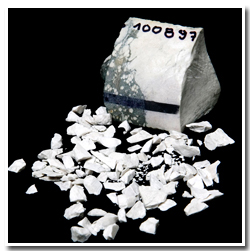
Highlights



|
 |
"Kryptonite" Confirmed: Superman Beware!
 |
| The name kryptonite is unlikely to stick when the new mineral (shown above) receives its official name later this year. |
Superman's nemesis, kryptonite, is no longer the stuff of fiction. A new mineral matching its unique chemistry – as described in the film Superman Returns – has been identified by scientists at NRC and the British Natural History Museum.
In Superman stories, exposure to kryptonite's large green crystals causes the superhero to weaken. But unlike the fictional rock, the new mineral is white, powdery and not radioactive. And rather than hailing from outer space, the real kryptonite was found in Serbia by the mining firm Rio Tinto. Unable to determine what it was, Rio Tinto sought help from Dr. Chris Stanley, a mineralogist at the Natural History Museum.
"Finding out that the chemical composition of a material submitted for review is an exact match to an invented formula for the fictitious kryptonite – this was the coincidence of a lifetime." – Dr. Yvon Le Page, NRC
Dr. Stanley measured the mystery material's chemical and optical properties. But in order to officially classify a new mineral, its crystal structure must also be determined. The sample's crystals were too small for traditional analytical methods. So the British scientist enlisted the expertise of NRC researchers Drs. Pamela Whitfield and Yvon Le Page to analyze and validate the mineral's crystal structure.
|

|
|
For other recent stories, see the summer issue of NRC NewsLink
|
Using state-of-the-art equipment, the NRC team concluded that the mineral was, as Dr. Stanley had suspected, a "new borosilicate material" worthy of being documented by the European Journal of Mineralogy. Later, when he searched the Web for the mineral's chemical formula – sodium lithium boron silicate hydroxide – Dr. Stanley was amazed to discover the same scientific name written on a case of rock containing kryptonite, which was stolen by arch-villain Lex Luthor in Superman Returns. Although the new mineral contains no fluorine, in all other respects its chemistry matches the fictional kryptonite.
Approximately 30-40 new minerals are discovered each year. Each must be registered with the International Mineralogical Association's Commission on New Minerals, Nomenclature and Classification, which determines if a new mineral is genuinely unique.
Recommended Link:
|
